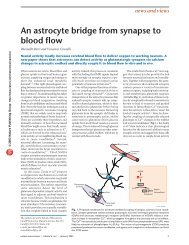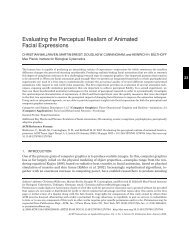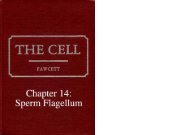Chapter 12: Centrioles
Chapter 12: Centrioles
Chapter 12: Centrioles
You also want an ePaper? Increase the reach of your titles
YUMPU automatically turns print PDFs into web optimized ePapers that Google loves.
CENTRIOLES<br />
In transverse section the cylindrical wall of the centriole is made up of nine<br />
longitudinally oriented triplet microtubules. A dense material of unknown nature<br />
occupies the interstices between the triplets. Each triplet is at a constant angle of<br />
about 40 degrees to its respective tangent. A pattern is thus formed that resembles<br />
the vanes of a turbine or the charges of a pyrotechnic "pinwheel." The innermost<br />
microtubule of each triplet has a circular cross section and is designated subunit<br />
a and the other two b and c. The latter two each share a segment of the wall of<br />
the adjacent microtubule and therefore have a C-shaped profile instead of a circular<br />
cross section. Subunit a has two short diverging projections resembling the arms on<br />
the doublets of the ciliary axoneme. One of these is directed inward along a radius<br />
and appears to have a free end pointing toward the center of the centriole. The<br />
other projection connects with subunit c of the next triplet. The successive triplets are<br />
thus linked together a to c around the circumference of the centriole by a series of linear<br />
densities. It is not known whether these latter correspond to the dynein arms or nexin<br />
links of flagellar axonemes.<br />
Figure 303. Centriole. (Micrograph courtesy of Susumu Ito.)<br />
Figure 304. Centriole from embryonic chick pancreas. (Micrograph courtesy of Jean Andre.)<br />
Figure 303, upper<br />
Figure 304, lower<br />
559









